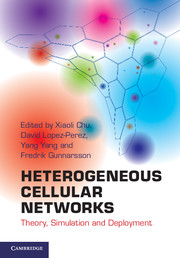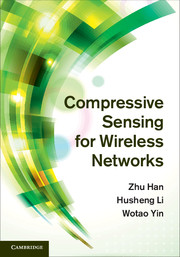Refine search
Actions for selected content:
6791 results in Communications and signal processing
10 - Cognitive radio networks
- from Part II - CS-Based Wireless Communication
-
- Book:
- Compressive Sensing for Wireless Networks
- Published online:
- 05 June 2013
- Print publication:
- 06 June 2013, pp 232-267
-
- Chapter
- Export citation
2 - Overview of wireless networks
-
- Book:
- Compressive Sensing for Wireless Networks
- Published online:
- 05 June 2013
- Print publication:
- 06 June 2013, pp 6-48
-
- Chapter
- Export citation
8 - Positioning
- from Part II - CS-Based Wireless Communication
-
- Book:
- Compressive Sensing for Wireless Networks
- Published online:
- 05 June 2013
- Print publication:
- 06 June 2013, pp 193-213
-
- Chapter
- Export citation
Part II - CS-Based Wireless Communication
-
- Book:
- Compressive Sensing for Wireless Networks
- Published online:
- 05 June 2013
- Print publication:
- 06 June 2013, pp 139-140
-
- Chapter
- Export citation
3 - Compressive sensing framework
- from Part I - Compressive Sensing Technique
-
- Book:
- Compressive Sensing for Wireless Networks
- Published online:
- 05 June 2013
- Print publication:
- 06 June 2013, pp 51-68
-
- Chapter
- Export citation
7 - Ultra-wideband systems
- from Part II - CS-Based Wireless Communication
-
- Book:
- Compressive Sensing for Wireless Networks
- Published online:
- 05 June 2013
- Print publication:
- 06 June 2013, pp 173-192
-
- Chapter
- Export citation
Part I - Compressive Sensing Technique
-
- Book:
- Compressive Sensing for Wireless Networks
- Published online:
- 05 June 2013
- Print publication:
- 06 June 2013, pp 49-50
-
- Chapter
- Export citation
Frontmatter
-
- Book:
- Compressive Sensing for Wireless Networks
- Published online:
- 05 June 2013
- Print publication:
- 06 June 2013, pp i-vi
-
- Chapter
- Export citation
1 - Introduction
-
- Book:
- Compressive Sensing for Wireless Networks
- Published online:
- 05 June 2013
- Print publication:
- 06 June 2013, pp 1-5
-
- Chapter
- Export citation
9 - Multiple access
- from Part II - CS-Based Wireless Communication
-
- Book:
- Compressive Sensing for Wireless Networks
- Published online:
- 05 June 2013
- Print publication:
- 06 June 2013, pp 214-231
-
- Chapter
- Export citation
4 - Sparse optimization algorithms
- from Part I - Compressive Sensing Technique
-
- Book:
- Compressive Sensing for Wireless Networks
- Published online:
- 05 June 2013
- Print publication:
- 06 June 2013, pp 69-117
-
- Chapter
- Export citation
Contents
-
- Book:
- Compressive Sensing for Wireless Networks
- Published online:
- 05 June 2013
- Print publication:
- 06 June 2013, pp vii-xii
-
- Chapter
- Export citation
References
-
- Book:
- Compressive Sensing for Wireless Networks
- Published online:
- 05 June 2013
- Print publication:
- 06 June 2013, pp 268-290
-
- Chapter
- Export citation
6 - Compressed channel estimation
- from Part II - CS-Based Wireless Communication
-
- Book:
- Compressive Sensing for Wireless Networks
- Published online:
- 05 June 2013
- Print publication:
- 06 June 2013, pp 141-172
-
- Chapter
- Export citation
5 - CS analog-to-digital converter
- from Part I - Compressive Sensing Technique
-
- Book:
- Compressive Sensing for Wireless Networks
- Published online:
- 05 June 2013
- Print publication:
- 06 June 2013, pp 118-138
-
- Chapter
- Export citation

Heterogeneous Cellular Networks
- Theory, Simulation and Deployment
-
- Published online:
- 05 June 2013
- Print publication:
- 23 May 2013

Compressive Sensing for Wireless Networks
-
- Published online:
- 05 June 2013
- Print publication:
- 06 June 2013
14 - Energy-efficient architectures and techniques
-
-
- Book:
- Heterogeneous Cellular Networks
- Published online:
- 05 June 2013
- Print publication:
- 23 May 2013, pp 426-452
-
- Chapter
- Export citation
Contents
-
- Book:
- Heterogeneous Cellular Networks
- Published online:
- 05 June 2013
- Print publication:
- 23 May 2013, pp vii-xv
-
- Chapter
- Export citation
12 - Network coding
-
-
- Book:
- Heterogeneous Cellular Networks
- Published online:
- 05 June 2013
- Print publication:
- 23 May 2013, pp 352-382
-
- Chapter
- Export citation
